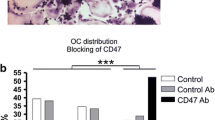Summary
We performed immunocytochemical localization of cathepsin D in osteoclasts of the proximal growth plate of the rat femurs using both the avidin-biotin-peroxidase complex method for cryo-semi-thin (1 μm) sections and the colloidal gold-labeled IgG method for K4M ultra-thin sections.
At the light microscopic level, cathepsin D immunoreactivity in the osteoclasts appeared at the vesicles, granules, and/or small vacuoles. They were distributed throughout the cytoplasm of each cell and were relatively numerous close to the bone surface. This antigen could not be detected at the eroded bone surface. As for other cells, immunoreactivity was seen only in the lysosomes of osteoblast-like cells. Immunoreactivity in the osteoclasts was stronger and greater in the density and number than in osteoblast-like cells. At the electron microscopic level, osteoclasts with well-developed ruffled border possessed numerous cathepsin D-containing lysosomes, vacuoles, and coated vesicle-like structures. Cathepsin D-containing lysosomes fused with cathepsinnegative vacuoles and formed large secondary lysosomes. Osteoclasts with poorly developed ruffled border possessed fewer cathepsin D-containing lysosomes than those with well-developed ruffled border. No immunogold particles were seen in vacuole-like channel expansions of the ruffled borders, between the channels of the ruffled borders, or on the eroded bone surface.
These findings demonstrate that osteoclasts contain a large amount of cathepsin D. They suggest that cathepsin D is necessary for osteoclastic bone resorption, that it plays an indirect rather than direct role.
Similar content being viewed by others
References
Baron R, Neff L, Louvard D, Courtoy PJ (1985) Cell-mediated extracellular acidification and bone resorption: evidence for a low pH in resorbing lacunae and localization of a 100-kD lysosomal membrane protein at the osteoclast ruffled border. J Cell Biol 101:2210–2222
Baron R, Neff L, Brown W, Courtoy PJ, Louvard D, Farquhar MG (1988) Polarized secretion of lysosomal enzymes: co-distribution of cation-independet mannose-6-phosphate receptors and lysosomal enzymes along the osteoclast exocytic pathway. J Cell Biol 106:1863–1872
Baron R (1989) Molecular mechanisms of bone resorption by the osteoclast. Anat Rec 224:317–324
Blair HC, Kahn AJ, Crouch EC, Jeffrey JJ, Teitelbum SL (1986) Isolated osteoclasts resorb the organic and inorganic components of bone. J Cell Biol 102:1164–1172
Blair HC, Teitelbum SL, Ghiselli R, Gluck S (1989) Osteoclastic bone resorption by a polarized vacuolar proton pump. Science 245:855–858
Burleigh MC (1977) Degradation of collagen by non-specific proteinase. In: Barrett AJ (ed) Proteinases in mammalian cells and tissues. North-Holland, Amsterdam, pp 284–309
Chambers TJ (1985) The pathobiology of the osteoclast. J Clin Pathol 38:241–252
Delaissé JM, Eeckhout Y, Vaes G (1984) In vivo and in vitro evidence for the involvement of cysteine proteinases in bone resorption. Biochem Biophys Res Commun 125:441–447
Delaissé JM, Ledent P, Eeckhout Y, Vaes G (1986) Cysteine proteinases and bone resorption. In: Trunk V (ed) Cysteine proteinases and their inhibitors. W de Gruyter, Berlin, pp 259–268
Etherington DJ, Birkedahl-Hansen H (1987) The influence of dissolved calcium salts on the degradation of hard-tissue collagens by lysosomal cathepsins. Collagen Rel Res 7:185–199
Fallon MD (1984) Bone resorbing fluid from osteoclasts is acidic — an in vitro micropuncture study. In: Chon DV, Fujita T, Potts JT Jr, Talmage RV (eds) Endocrine control of bone and calcium metabolism. Elsevier, Amsterdam, pp 144–146
Holtrop ME, Raisz LG, Simmons HA (1974) The effects of parathyroid hormone, colchicine, and calcitonin on the ultrastructure and the activity of osteoclasts in organ culture. J Cell Biol 60:346–355
Lucht U (1972) Cytoplasmic vacuoles and bodies of osteoclast. An electron microscope study. Z Zellforsch 135:229–244
Miller SC (1977) Osteoclast cell-surface changes during the egg-laying cycle in Japanese quail. J Cell Biol 75:104–118
Miller SC (1978) Rapid activation of the medullary bone osteoclast cell surface by parathyroid hormone. J Cell Biol 76:615–618
Nishimura Y, Kawabata T, Yano S, Kato K (1990) Intracellular processing and activation of lysosomal cathepsins. Acta Histochem Cytochem 23:53–64
Pagano M, Capony F, Rochefort H (1989) La pro-cathepsine D peut activer in vitro la pro-cathepsine B sécrétée par les cancers ovariens. C R Acad Sci Paris 309:7–12
Sakamoto M, Sakamoto S (1984) Immunocytochemical localization of collagenase in isolated mouse bone cells. Biomed Res 5:29–38
Scott PG, Pearson H (1981) Cathepsin D: specificity of peptidebond cleavage in type-I collagen and effects on type-III collagen and procollagen. Eur J Biochem 114:59–62
Slot JW, Geuze HJ (1985) A new method of preparing gold probes for multiple-labeling cytochemistry. Eur J Cell Biol 38:87–93
Tanaka T, Morioka T, Ayasaka N, Iijima T, Kondo T (1990) Endocytosis in odontoclasts and osteoclasts using microperoxidase as a tracer. J Dent Res 63:883–889
Tanaka T, Tanaka M (1988) Cytological and functional studies of preosteoclasts and osteoclasts in the alveolar bones from neonatal rats using microperoxidase as a tracer. Calcif Tissue Int 42:267–272
Väänänen HK, Karhukorpi E-K, Sundquist K, Wallmark B, Roininen I, Hentunen T, Tuukkanen J, Lakkakorpi P (1990) Evidence for the presence of a proton pump of the vacuolar H+-ATPase type in the ruffled borders of osteoclasts. J Cell Biol 111:1305–1311
Vaes G (1968) On the mechanisms of bone resorption. The action of parathyroid hormone on the excretion and synthesis of lysosomal enzymes and on the extracellular release of acid by bone cells. J Cell Biol 39:676–697
Vaes G (1988) Cellular biology and biochemical mechanism of bone resorption. A review of recent developments on the formation, activation, and mode of action of osteoclasts. Clin Orthop 231:239–271
Yamamoto K, Kamata O, Katsuda N, Kato K (1980) Immunochemical difference between cathepsin D and cathepsin E-like enzyme from rat spleen. J Biochem 87:511–516
Yamamoto K, Takeda M, Yamamoto H, Tatsumi M, Kato Y (1985) Human erythrocyte membrane acid proteinase (EMAP): sidedness and relation to cathepsin D. J Biochem 97:821–830
Author information
Authors and Affiliations
Rights and permissions
About this article
Cite this article
Goto, T., Tsukuba, T., Ayasaka, N. et al. Immunocytochemical localization of cathepsin D in the rat osteoclast. Histochemistry 97, 13–18 (1992). https://doi.org/10.1007/BF00271276
Accepted:
Issue Date:
DOI: https://doi.org/10.1007/BF00271276




